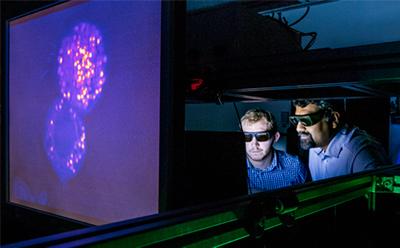Southampton researchers to tackle threat of antibiotic resistance in new £2.8m laboratories

Researchers from the University of Southampton will assess rapid diagnosis technologies and treatments against antibiotic resistant infections in new research laboratories at University Hospital Southampton.
The university-hospital partnership and Global Network for Anti-Microbial Resistance and Infection Prevention (UoS NAMRIP) has won £2.8 million in funding for the facilities as part of a £32 million package awarded to ten sites nationally by the Department of Health and Social Care.
Interdisciplinary experts, including Professor Sumeet Mahajan from the School of Chemistry and Institute for Life Sciences, will use the hub to interact with clinicians to test new diagnostic ideas and pursue opportunities for near-patient research.
Overuse of antibiotics has driven anti-microbial resistance (AMR) - the emergence of bacteria and fungi strains immune to their effects, resulting in infections that kill over 5,000 people each year in the UK. That figure is rising year-on-year and globally there is concern that new strains may emerge that are resistant to all existing antibiotics.
Southampton is already at the forefront of clinical research in infectious diseases through studies such as a pioneering use of genetically-modified harmless bacteria by Professor Robert Read, Director of the NIHR Southampton Biomedical Research Unit and lead applicant on the facilities award.
Another key new avenue to be pursued is the use of advanced Raman and label-free imaging techniques for in situ AMR and biofilm diagnostics in the clinic.
This work is being spearheaded in a collaboration between the University’s Professor Sumeet Mahajan, Professor Jeremy Webb and Professor Saul Faust, following advances from a European Research Council starting grant (NanoChemBioVision).
“Our underpinning work has shown that using these techniques innovatively can allow classification and identification of microbes at the species and the strain level as well as the characterisation of biofilms, including their extracellular matrix,” Professor Mahajan said.
“The uniqueness of the methods is that they do not require sample preparation or processing or culture and can be done in situ on the clinical sample within minutes, if not faster. Thus, they have the potential to transform diagnostics by providing an early detection method where ‘chemical’ spectral patterns can provide biomarkers for AMR and in principle could also allow monitoring of treatment.”
The new laboratories will include equipment for high-content automated Raman spectroscopy and advanced label-free imaging to enable this work. Professor Tim Leighton, Director of UoS NAMRIP, said: “This award is a huge achievement and we are extremely grateful to the Department of Health and Social Care. This is an enormous opportunity to close the loop of researchers working with end users to define the key problems and opportunities to address AMR, conduct ground-breaking research to address those, and then progress to end users who can ensure breakthroughs are translated out to benefit on a societal scale.”